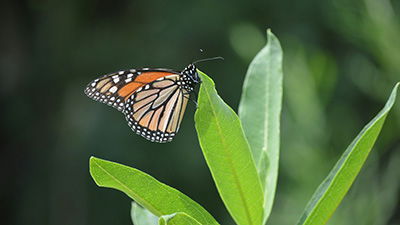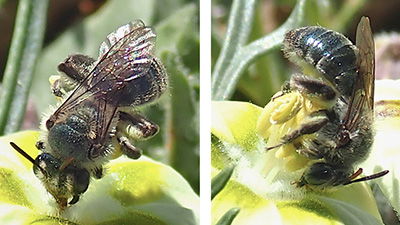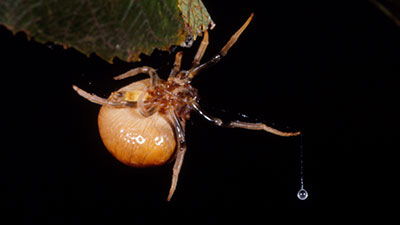
Spectacular Spider Fossils—How Do We Explain the Evidence?
Paleontologists working in the Jinju Formation (Early to Mid-Cretaceous) in southeast South Korea discovered ten well-preserved spider specimens in shale. Conventionally dated at 112–110 MY, this shale also contains numerous fossils of insects, plants, bivalves, fish, and crustaceans. Of the ten spider fossils, two, from the extinct Family Lagonomegopidae had tapeta in their eyes.
Glowing Eye Structures Preserved
Tapeta are light-reflective mirrors (membranes) composed of guanine crystals, at the back of the retina in certain animals that allow for enhanced night vision (this causes the eye of the animal to appear to glow in the dark—cats being a perfect example). Lagonomegopidae (which is Greek for “large eye on the side”) have a single large eye (as well as smaller secondary eyes) that sits more on the side of these spiders’ heads rather than on top, as in most other spider families.
Typically, spider fossils are poorly preserved unless entombed in amber. Their soft bodies and delicate features are usually destroyed in other modes of fossilization. These particular spider fossils (compression fossils), however, not only revealed the tapeta of two spider species but even the fine hairs on some of the legs. To propose that this level of fine detail could be preserved 110 MY strains credulity.
A Large-Scale Catastrophe?
The Jinju Formation consists of finely laminated, very dark gray shale, which even evolutionary paleontologists admit was laid down rapidly (at least in localized areas). In fact, some of the most startling claims of catastrophic preservation come from the authors of the study when interviewed by science writers for layman summaries of their journal article.
“Because these spiders were preserved in strange slivery flecks on dark rock, what was immediately obvious was their rather large eyes brightly marked with crescentic features,” said Paul Selden, coauthor of the Journal of Systematic Palaeontology article. “I realized this must have been the tapetum—that’s a reflective structure in an inverted eye where light comes in and is reverted back into retina cells. This is unlike a straightforward eye where light goes through and doesn't have a reflective characteristic.”1
We don’t really know what caused this, but something killed off a lot of animals around the lake at one time or on an annual basis.
“This is so rare because they’re very soft — they don't have hard shells, so they very easily decay,” Selden said. “It has to be a very special situation where they were washed into a body of water. Normally, they’d float. But here, they sunk, and that kept them away from decaying bacteria—it may have been a low-oxygen condition. These rocks also are covered in little crustaceans and fish, so there maybe was some catastrophic event like an algal bloom that trapped them in a mucus mat and sunk them—but that's conjecture. We don’t really know what caused this, but something killed off a lot of animals around the lake at one time or on an annual basis.”2
The spiders in the Jinju Formation have been washed into the freshwater environment from a variety of habitats.3
The Evolutionary Explanation Doesn’t Add Up
The Jinju Formation is comprised of 3,300 to 5,900 ft. thick (1000 to 1800 m) grey to black shale intercalated by packets of sandstones and is interpreted to have been deposited in a river and lake environment, but as noted in the Systematic Palaeontology journal article there is considerable marine fauna present in the formation.
The presence of albuiform fish fossils and occurrence of Archaeoniscus isopod fossils might suggest a marine connection to the basin for this succession. However, the other, overwhelming occurrences of terrestrial fossils, such as plants, ostracods [tiny freshwater shrimp-like animals], freshwater molluscs and pollen, indicate that the basin was largely non-marine.4
From a flood geology perspective, it is much more likely that these freshwater creatures as well as the spiders, terrestrial plants and insects were buried immediately.
However, from a flood geology perspective, it is much more likely that these freshwater creatures as well as the spiders, terrestrial plants and insects were buried immediately in their terrestrial (and lakeside) environment, being quickly overlain by transgressed sediment. This would also more readily explain how the marine and/or freshwater organisms (like the fish, mollusks, and crustaceans) were buried with the terrestrial organisms and also how the stromatolites were subsequently buried on top of them. This would also account for the proposed low-oxygen environment; and allow for exquisite preservation of many of the fossils, as decay-causing bacteria would not have been able to survive and do their work of breaking down organic matter. This muddy sediment would have also been compressed as the Flood continued to dump hundreds of feet of mud and clay into what was once a terrestrial and fluvial-lacustrine basin. This would be an ideal means to preserve compression molds of soft-bodied creatures.
The Biblical Flood Better Explains the Data
Dr. Selden’s comment above about spiders normally floating when washed into a body of water is quite correct. That these spiders were so well-preserved mandates that were covered by sediment catastrophically and immediately. The fact that they were entombed with diverse terrestrial plant and animal life, as well as freshwater and marine organisms further highlights the catastrophic nature of their burial and makes the algal bloom/mucus mat conjecture speculative at best. Ironically, the only evidence of algal mats (actually cyanobacterial stromatolites) occurs 10 to 25 meters above where the spider fossils were found.5 This would indicate either an excessively large catastrophic event or the stromatolites would have formed much later than the event which entombed the spiders (in a conventional geological timeline).
If this particular cache of spider fossils were to be interpreted as an annual event, as postulated by Dr. Selden, then why are there not stromatolites found throughout the formation? And why a mix of terrestrial, freshwater and marine organisms? In fact, in the layers where the spiders were immediately found, the most prominent fossils were insects and fish. The spiders described in the paper are not water spiders, and most are described as being cursorial (running, ground-dwelling).6 But the most telling aspect of the immediate catastrophic death and burial of these spiders is their leg positions. All but one of the spider specimens had their legs extended when they were fossilized. This means that that had to have been buried at the same moment they died, or else their legs would have curled up. Spider legs extend due to hydraulic pressure, and when they die the flexor muscles in their legs immediately contract due to lack of pressure.7 For the one specimen which had curled legs (Jinjumegops dalingwateri) the most plausible explanation is that it had died (perhaps of natural causes) shortly before being buried. The rest of these spiders, however, were catastrophically buried while going about their daily routines in their environment! The worldwide flood recorded in Genesis 6-8 explains the fossil evidence in this location much more conclusively.
Footnotes
- University of Kansas, “Ancient Spider Fossils, Surprisingly Preserved in Rock, Reveal Reflective Eyes,” Phys.org, February 12, 2019, https://phys.org/news/2019-02-ancient-spider-fossils-surprisingly-reveal.html.
- Ibid.
- Tae-Yoon S. Park, Kye-Soo Nam, and Paul A. Selden, “A Diverse New Spider (Araneae) Fauna from the Jinju Formation, Cretaceous (Albian) of Korea,” Journal of Systematic Palaeontology (January 28, 2019): 22, doi:10.1080/14772019.2018.1525441.
- Ibid., 2–3.
- Ibid., 4 (specifically, see Figure 2).
- Ibid., 22.
- “Spider Legs and How They Work,” The Infinite Spider, December 16, 2014, https://infinitespider.com/spider-legs-work/.

Answers in Genesis is an apologetics ministry, dedicated to helping Christians defend their faith and proclaim the good news of Jesus Christ.
- Customer Service 800.778.3390
- Available Monday–Friday | 9 AM–5 PM ET
- © 2025 Answers in Genesis



